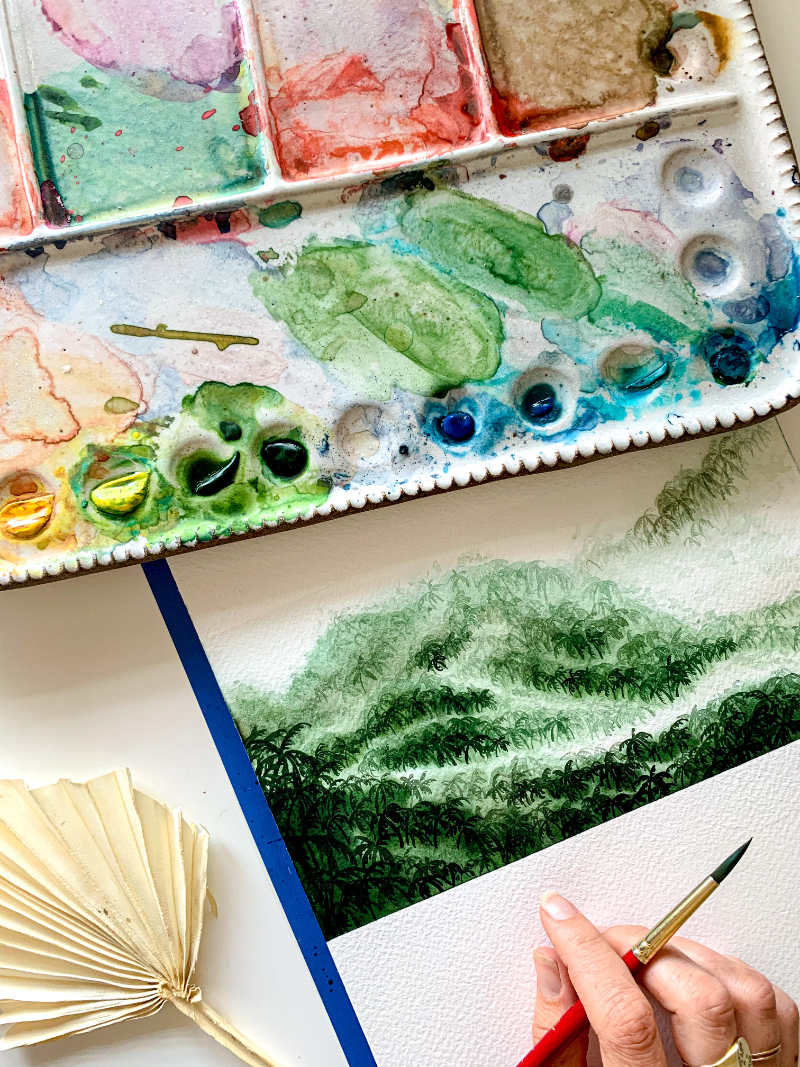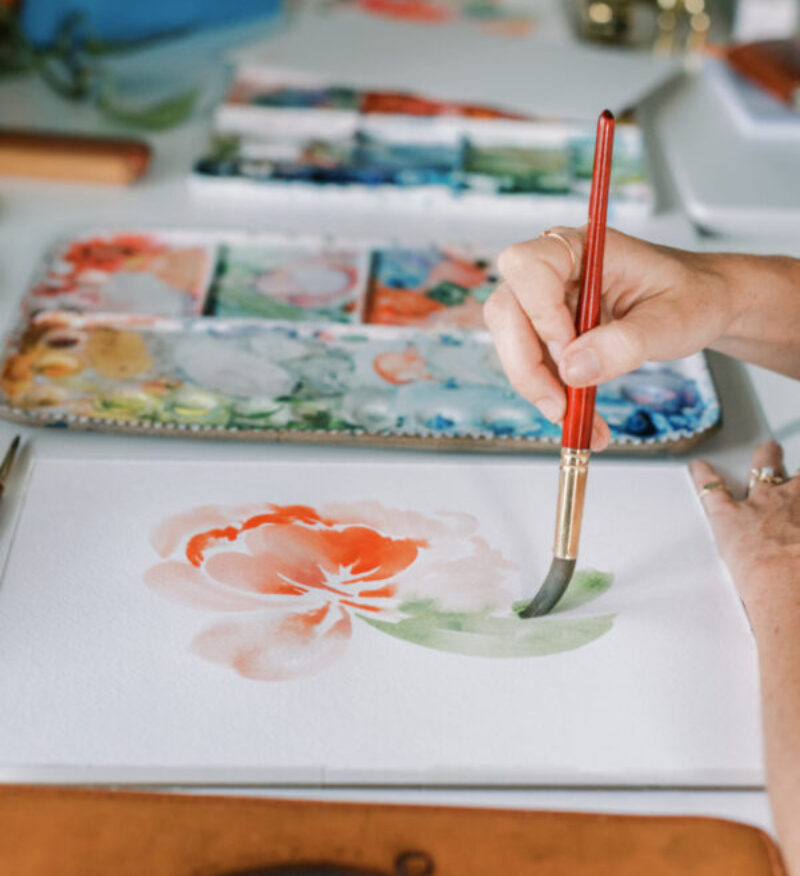We all have that drawer. You know the one—overflowing with watercolor florals, half-finished zinnias, a few splashes of abstract experiments, and pieces you kind of love… but don’t know what to do with.
Sound familiar?
Whether you’re a total beginner or have shelves stacked with sketchbooks, figuring out what to do with your art (especially the “meh” pieces) can feel overwhelming. But here’s the good news: your art doesn’t have to be “perfect” to have purpose. Let’s walk through a gentle, joyful process for honoring all your creations, finished or not.

Start With Some Gentle Sorting
Let’s begin here. Before we dive into what to do with your art, it helps to take stock. Before you panic, there’s no pressure to toss everything or create a color-coded filing system (unless that lights you up!).
Just start with two simple piles:
- Finished pieces you like or love
- Unfinished, experimental, or “not-so-sure” pieces
You might also want a third pile: the what-was-I-thinking stack (we all have one). Give yourself permission to laugh a little and keep moving.
Once you've sorted your art, you can explore the next step. And that’s when you get to decide: what to do with your art now that it’s been seen with fresh eyes?
What to Do With Finished Art You Love
When a piece actually turns out just right (or close enough to spark a smile) don’t let it sit in the shadows of a closed sketchbook. If you’re wondering what to do with your art when it actually turns out well, here are a few ideas to bring it to life:
1. Display It (Yes, Even the Small Ones)
Frame your favorites (hello, gallery wall vibes!), tuck minis into floating shelves, or clip a few to a wire grid. If you paint a lot of watercolor florals or seasonal pieces, you can even rotate them like art calendar pages. A simple frame and some washi tape go a long way.
I also love scanning high-resolution versions of my favorites and printing smaller sizes to use as:
- Postcards
- Art journaling inserts
- Gifts for friends
And if you want creative display ideas for small pieces, check out this blog on organizing your art space. It’s full of helpful, doable tips!
2. Archive It (Without Overwhelm)
If you're not ready to part with it but don't want it on display, grab an acid-free portfolio or simple art folder. This is great for keeping track of your progress (especially if you're taking a watercolor course).
Add dates. Note what supplies you used. Write a little post-it about what you learned. You'll thank yourself later.
3. Give It New Life
Some of your favorite finished pieces can become:
- Greeting cards (I have a full DIY watercolor card tutorial on YouTube!)
- Bookmarks
- Wrapping paper
- Wall art as gifts
You can also scan and sell them as digital downloads or prints, especially if you’re thinking about dipping a toe into the world of selling your art. (If that’s you, my Guide to Selling Your Art can help!)

What to Do With Unfinished or “Meh” Art
Ah, the awkward middle. These are the pieces that feel unresolved, rushed, or just plain weird. Don’t worry, these are just as valuable as the finished ones. Maybe even more.
Here’s how to make peace with them (and maybe even use them!):
1. Repurpose It
Cut it up! Yep, really.
- Crop a corner into a mini print or journaling card
- Use swatches as washi tape or collage layers
- Turn textures or color tests into background pieces
These become great additions to your sketchbook, watercolor journal, or even your packaging if you’re shipping art or prints. You might even discover that figuring out what to do with your art you didn’t love opens up new ways to play and experiment.
2. Turn It Into a Learning Tool
Write notes directly on the back: “Used too much water here,” “Love this color mix,” or “Try a bigger brush next time.” Treat it like a watercolor diary.
You can also reuse the paper (if it’s not too warped) for warmups, swatching, or practicing new techniques.
I talk more about building a routine that encourages fresh ideas in my blog post here.
3. Let It Go (Without Guilt!)
Sometimes, the kindest thing you can do is recycle it. Not everything is meant to be kept forever. Your value as an artist isn’t in how many “keepers” you have, it’s in your curiosity and courage to keep showing up.
Give yourself permission to release old pieces to make space for new ones.
And if it helps, I’ve torn up a whole stack of old florals that made me cringe. It felt so good. Trust that letting go is part of learning what to do with your art, too.
Create a System That Works for You
Here’s a secret: every artist’s system is a little different. There’s no perfect way to store, show, or sort your art but having a simple system in place can make your creative flow smoother.
Try this:
- Keep a digital folder for scans of your finished work
- Store originals in a labeled portfolio or accordion file
- Use a drawer or bin for scraps, cutouts, and experiments
You can even have a “maybe” folder for pieces you want to revisit later. When you're regularly deciding what to do with your art, this kind of system helps keep it fun instead of stressful.

The Art You Don’t Keep Still Counts
Just because something doesn’t make it to a frame or folder doesn’t mean it wasn’t worth creating. Every brushstroke builds skill, every “oops” teaches you something new.
Think of your unfinished or tossed pieces as compost. They feed your future growth.
You’re not just painting for pretty results, you’re painting for joy, for curiosity, for yourself. (And that’s the best reason of all.)
Skip the mess and frustration, learn the watercolor lessons I had to discover the hard way. From rogue water blooms to brushes that betray you, these 5 tips will save your sanity (and your supplies).
Ready to Give Your Art New Life?
Whether you’re framing a favorite floral or turning a “meh” into a mini bookmark, I hope you feel a little more confident knowing what to do with your art.
If you’re looking for more ideas on how to stretch your creativity, head over to my YouTube channel for step-by-step tutorials. Or check out my course The Art Within, designed to help you build not just technique, but your unique style and artistic voice.
And if you need a little nudge, try a mini art challenge (like painting one flower a day for a week). You’ll be surprised at how much progress blooms when you simply keep going. You’ve got this!












+ show Comments
- Hide Comments
add a comment